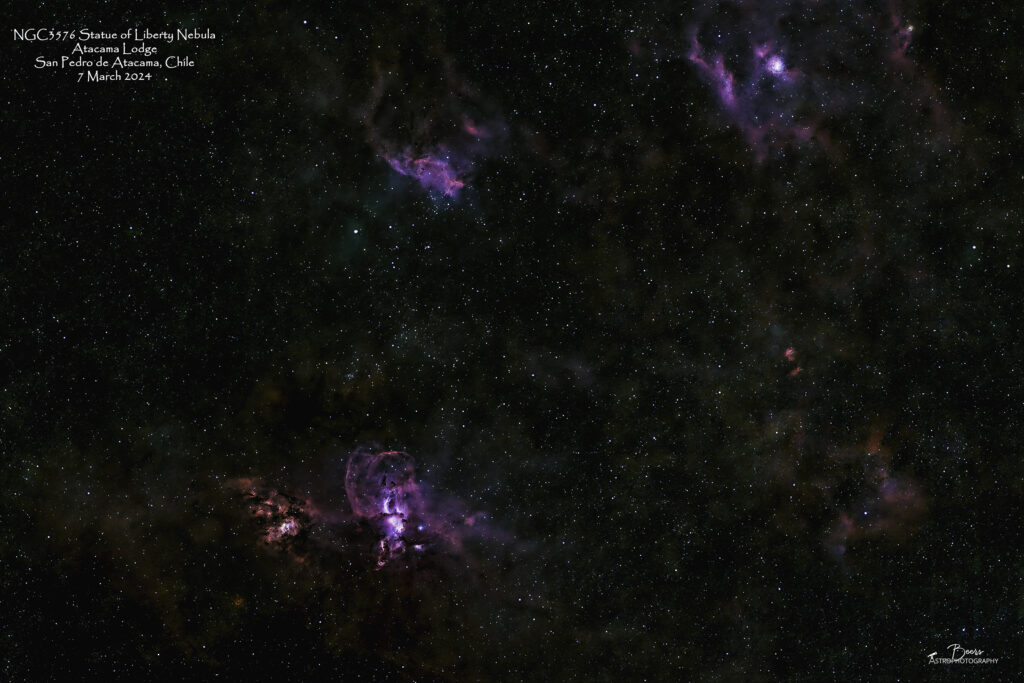
Fun facts
NGC 3576 is a bright emission nebula in the Sagittarius arm of the galaxy a few thousand light-years away from the Eta Carinae nebula. It is also approximately 100 light years across and 9000 light-years away from Earth. It was discovered by John Frederick William Herschel on 16 March 1834. This nebula has received six different classification numbers. Currently, astronomers call the entire nebula NGC 3576. A popular nickname is “The Statue of Liberty Nebula” because of the distinctive shape in the middle of the nebula. The name was first suggested in 2009 by Dr. Steve Mazlin, a member of Star Shadows Remote Observatory (SSRO). Within the nebula, episodes of star formation are thought to contribute to the complex and suggestive shapes. Powerful winds from the nebula’s embedded, young, massive stars shape the looping filaments.
Distance: 6000 light years
Radius: 50 light years
Constellation: Carina
Designations: GAL 291.30-00.7, RCW 57A, BRAN 348A, GAL 291.27-00.71, [GG70] 291.3-0.7, GAL 291.28-00.71, GUM 38a, [GS70] 291.3-00.7
{ From https://en.wikipedia.org/wiki/NGC_3576 }
Capture & Processing Notes
I imaged NGC3576 on night #2 (7 March 2024) of the Atacama dessert trip between astronomical twilights and captured 100x5min exposures.
I started out the session by ensuring the parking locations, within the mount’s software using the handcontroller, were correct for “Default” which I changed to “Current Location” and Northern and Southern Hemisphere park locations. Validating with a GoTo command with the hand controller that they were set and working correctly.
Then I moved onto the polar alignment and had a bit of a scare starting up with Polemaster, when I couldn’t recognize Sigma Octantis and moved the mount (significantly) from its polar aligned position the night before. I was beginning to panic when Danita came out and saved the day by correctly identifying it on the Polemaster screen – whew! Then a bit more of a delay when I started the sequence without turning on the mount – wondering why SGP was experiencing such a delay in slewing. After I figured it out, Danita suggested “maybe you should have a flight checklist.” To which I responded “Yes, Paul. I have a checklist – it’s in my notebook over there!” We both got a good stress-reducing laugh out of that!
With the mount on, the sequence started without issue – giving me about 20 minutes to partake in Alain’s star tour – visually seeing a nebula, star cluster, galaxy, and planetary nebula through his 45” (hand-made) telescope! …and was in total amazement of how he easily he pointed the telescope to each object, so we could climb up the steps and look at them in all their close-up glory!
At the meridian flip (that I had turned off “auto meridian flip” since I never use it and was being asked if I wanted to wait for the flip after I’d completed a successful flip to the post-meridian side of the pier), the mount again parked at the N Hemi park location. I flipped it around using the iHubo controller, then attempted to restart the sequence – it went through plate solving correctly, but the auto-guider never came back on-line.
I force-terminated the sequence with “Run end of Sequence Actions” then rebooted everything (SW and laptop) and dis/re-connected the auto-guider cable. When I restarted the sequence, everything worked well…so I believed that would be my mode of operations for the rest of this trip at the meridian flip – complete reboot.
The sequence ran to fruition, eerily taking its 100th subframe at the exact time (0637) that I woke up (3 minutes before the alarm). So, when I went out to end the sequence the telescope was already parked (in the N. Hemisphere aspect). I didn’t change it before disconnecting the mount, so I will start night #3 from that position to see if it really makes a difference…(teaser: it DOES matter and I spent the rest of the trip manually slewing the mount from 0, 270 (i.e., pointing west) to 0.90 (i.e., pointing east) at the end of each sequence. I also submitted the question to SGP Forum to see if there is a setting that I’m missing to define the home position within the equipment profile – they came back with an answer – that didn’t help, thus the manual slewing for the rest of the trip.
BTW – after processing this image, I’ve added it to my “image again on the next trip” list with the object more properly framed.
Sequence Plan:
- Sequence plan: Gain: 158, Temp: -0°C, offset=30; 100x5min; Total exposure time: 500 minutes, 8:20 hours.
- Captured: 7 March 2024 (7Mar2024, 2138 CDT – 8Mar2024, 0642 CDT);
- Shooting location: Atacama Lodge, San Pedro de Atacama, Chile
Processing summary: Captured with SGP. Stacked in APP. Star removal with Starnet++. Processed in LR/PS
Equipment
All equipment controlled by HP Probook (DSO CTRL 1) Windows 10 laptop running Sequence Generator Pro v4.3.0.1305.
- Polar alignment: QHYCCD camera (controlled by Polemaster for polar alignment)
- Imaging: (Southern Cross) Askar FRA600 on Rainbow Astro RC-135E, ZWO ASI2400MC#1 camera
- Autofocuser: ZWO EAF ( Electronic Automatic Focuser)
- Mount: Rainbow Astro RST-135E (controlled by iHubo ASCOM driver)
- Autoguiding: Orion 60mm Multi-Use Guide Scope with Orion StarShoot AutoGuider Pro Mono Astrophotography Camera (controlled by PHD2)
